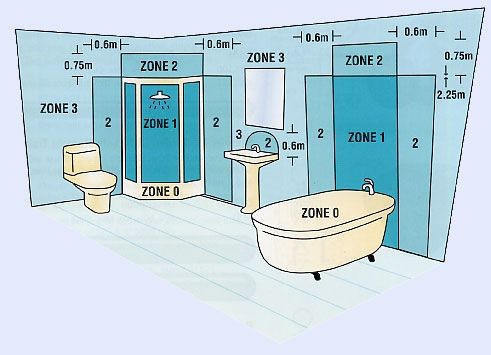Bathroom IP rating zones

Electrical appliances in bathrooms have special safety regulations. We have created this page to give you some simple guidance in choosing appropriate lighting and heating that will satisfy these regulations.
Electrical equipment in bathrooms must be protected against ingress of water. The I.E.E. Wiring regulations (BS 7671: 2001 Section 601) has mandatory requirements for areas containing a bath or shower. These safety standards are measured in zones, with the requirements for each zone being based on the perceived degree of risk of electric shock.
There are four precisely dimensioned zones: 0, 1, 2 and 3.
It is important to understand the rating by which bathroom lighting and heating is classified. IP rating stands for ‘Ingress Protection’ and is followed by two characters. The first specifies the degree of protection against particles or solid objects. The second specifies the degree of protection against liquids.
- Zone 0 = 12v IP67 and above
The interior of the bath or shower which can hold water. Any fittings used here must be SELV (max. 12V) and be rated IPX7 (protected against immersion in water).
- Zone 1. = IP65 and above and covered by 30mA RCD if 240v
The area directly above Zone 0 vertically to 2.25m above the bottom of the bath or shower. A minimum rating of IPX4 is required (See note 1)
The area beyond zones 0 and 1, 0.6m horizontally and up to 2.25m vertically. Zone 2 also includes any window with a sill next to the bath. An IP rating of at least IPX4 is required (See note 1)
- Zone 3. = Ip20 and above as long as no water jets are likely
The area beyond zones 2, 2.4m horizontally and up to 2.25m vertically. Where water jets are not to be used for cleaning purposes, the general rules of BS7671 apply (See note 1)
- In zones 1, 2 & 3, if there’s a likelihood of water jets being used for cleaning purposes, a min. of IPX5 is required.
- Where ceiling heights exceed 2.25m, the zones are effectively up to 3m - beyond 3m, the walls are out of scope.
- Basins are not covered, however they are usually considered to be zone 2.
- Providing the space under the bath cannot be accessed without using tools to gain access, that space is considered to be out of zone. However, if in any doubt please check.
| FIRST NUMBER |
SECOND NUMBER |
| 0 No protection |
0 No protection |
| 1 Protected against solid objects greater than 50mm (e.g. accidental touch by hands) |
1 Protection against vertically falling drops of water (e.g. condensation) |
| 2 Protected against solid objects up to 12mm (e.g. fingers) |
2 Protection against direct sprays of water up to 15 degrees from vertical |
| 3 Protected against solid objects greater than 2.5mm (e.g. tools and wires) |
3 Protection against direct sprays of water up to 60 degrees from vertical |
| 4 Protected against solid objects greater than 1mm (e.g. small tools and wires) |
4 Protection against water sprayed from all directions - limited ingress permitted |
| 5 Protected against dust, limited ingress (e.g. no harmful deposit) |
5 Protected against low pressure jets of water from all directions - limited ingress permitted |
| 6 Totally protected against dust |
6 Protected against high pressure jets of water (use on ship deck) - limited ingress permitted |
| |
7 Protected against the effects of immersion between 15cm and 1m |
| |
8 Protected against long periods of immersion under pressure |
* The information contained on this page is for guidance only: always refer to the current IEE reguations or a qualified electrician to ensure that you are guided by the latest regulations and code of practice